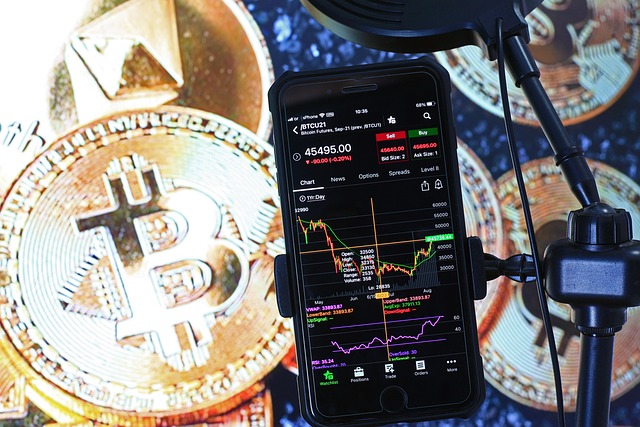TL;DR:
Investors in cryptocurrency during stock market crashes should understand the distinction between hot and cold wallets: hot wallets offer quick access but less security, while cold wallets provide superior protection by keeping keys offline. A multi-wallet strategy combining both types is advisable for safety. Key practices include diversifying investments, enabling 2FA, regularly backing up private keys offline, using hardware wallets for long-term storage, and never sharing recovery phrases. Proactive investors stay informed about trends and updates, rebalance portfolios, and explore new security measures like hardware wallets during downturns to protect their crypto assets.
In today’s digital landscape, cryptocurrency wallets are not just storage spaces but crucial fortresses guarding your digital assets. With crypto investments becoming increasingly popular, understanding wallet security best practices is vital, especially during tumultuous economic periods like stock market crashes. This article delves into essential strategies to fortify your crypto holdings, covering topics from wallet types and their security roles to backup plans, multi-factor authentication, and staying informed amidst market volatility, offering guidance for navigating the challenging yet promising world of crypto investment during stock market crashes.
- Understanding Cryptocurrency Wallets: Types and Security Roles
- The Impact of Stock Market Crashes on Crypto Investments
- Best Practices for Securing Your Digital Assets During Crashes
- Backup and Recovery Strategies for Unforeseen Events
- Multi-Factor Authentication (MFA): An Extra Layer of Protection
- Staying Informed: Monitoring and Updating Security Measures
Understanding Cryptocurrency Wallets: Types and Security Roles

Cryptocurrency wallets are essential tools for any investor in digital assets, serving as secure repositories for private keys that facilitate crypto transactions. There are various types, including hot wallets (online, convenient but less secure) and cold wallets (offline, more secure but less accessible). Understanding these distinctions is crucial, especially during volatile periods like stock market crashes when crypto investment gains popularity.
Each wallet type plays a unique role in security. Hot wallets enable quick access to funds, ideal for frequent trades, but require robust security measures against online threats. Cold wallets, often hardware-based, offer superior protection by keeping keys out of reach of digital attacks. For investors considering crypto during market downturns, adopting a multi-wallet strategy—combining the accessibility of hot wallets with the security of cold storage—can be a wise practice to safeguard digital assets.
The Impact of Stock Market Crashes on Crypto Investments

When it comes to crypto investment during stock market crashes, the impact can be both positive and negative. Historically, cryptocurrency has shown resilience in the face of traditional market downturns, with some investors viewing it as a hedge against economic uncertainty. During stock market crashes, crypto assets often experience volatility but tend to rebound faster than their conventional counterparts. This makes them an attractive option for diversifying investment portfolios and mitigating risk.
However, it’s essential to understand that crypto markets are highly speculative and subject to rapid price swings. A stock market crash can lead to increased panic selling in cryptocurrencies, causing prices to plummet. Investors who fail to secure their digital assets properly may find themselves at significant risk of loss. Therefore, best practices for crypto investment during such events include holding a diversified portfolio, enabling two-factor authentication, and regularly backing up private keys offline to protect against potential market turmoil.
Best Practices for Securing Your Digital Assets During Crashes

During stock market crashes, crypto investors often face a unique challenge—protecting their digital assets from both market volatility and potential security threats. The first best practice is to diverge your portfolio across multiple cryptocurrencies and exchanges. By spreading your investments, you reduce the risk of significant losses if one particular coin or exchange suffers a breach. Additionally, enabling two-factor authentication (2FA) on all wallets is paramount. 2FA adds an extra layer of security by requiring not just your password but also a unique code sent to your device.
Further, it’s crucial to regularly update your software and apps. Developers constantly patch vulnerabilities that hackers exploit. Keeping your crypto wallet software up-to-date ensures you benefit from these fixes. Additionally, consider using hardware wallets for long-term storage. These offline devices store private keys in a secure environment, eliminating the risk of online attacks. Lastly, never share your private keys or recovery phrases, and back up your data securely to prevent unauthorized access.
Backup and Recovery Strategies for Unforeseen Events

In the volatile world of cryptocurrency, unforeseen events such as hardware failures or security breaches can pose significant risks to your digital assets. A robust backup and recovery strategy is therefore essential for every crypto investor. During stock market crashes or economic downturns, when traditional investment portfolios may suffer, a well-protected crypto wallet can offer a glimmer of stability. Regularly backing up your private keys in secure, offline locations ensures that even if your primary device is compromised, your crypto investments remain accessible.
Diversifying backup methods further enhances security. Cloud storage solutions, physical hard drives, and paper wallets are all viable options for safeguarding your recovery phrases. It’s crucial to keep these backups separate from each other and stored in different secure locations. This multi-layered approach mitigates the impact of potential disasters, ensuring that you can quickly regain access to your cryptocurrency during uncertain times, when stock market crashes may drive investors towards digital assets as a haven.
Multi-Factor Authentication (MFA): An Extra Layer of Protection

In today’s digital age, where crypto investments have gained significant traction, especially during stock market crashes, securing your digital assets is paramount. Multi-Factor Authentication (MFA) serves as an essential and powerful tool in this regard, offering an extra layer of protection beyond just a password. By requiring multiple forms of identification, such as a one-time code from your phone or biometric data, MFA significantly reduces the risk of unauthorized access to your cryptocurrency wallet.
This added security measure ensures that even if someone manages to obtain your password, they still won’t be able to gain entry without the second factor. Consequently, it becomes much harder for hackers to compromise your crypto investment, providing peace of mind during uncertain market periods when investors are more susceptible to cyberattacks.
Staying Informed: Monitoring and Updating Security Measures

In the dynamic landscape of cryptocurrency, staying informed is a cornerstone of robust security practices. Investors who embrace this philosophy are better equipped to navigate volatile markets, such as those during stock market crashes. Keeping abreast of industry trends and emerging threats allows crypto enthusiasts to update their security measures accordingly. This proactive approach involves regularly checking for updates in wallet software, which often include enhanced encryption methods and bug fixes that address potential vulnerabilities.
During uncertain economic periods, when market fluctuations can drive both excitement and apprehension, informed investors make timely decisions regarding their crypto holdings. They might rebalance their portfolios, diversify investments, or even explore new security measures like hardware wallets. Staying vigilant and adaptable ensures that their digital assets remain secure amidst the ever-changing crypto ecosystem, including during stock market crashes and subsequent recoveries.
Securing your cryptocurrency wallet is paramount, especially during turbulent financial times like stock market crashes. By understanding the diverse types of crypto wallets and their security roles, implementing robust practices such as multi-factor authentication (MFA), and staying informed about market trends, investors can better protect their digital assets. Regular backups and recovery strategies are essential to safeguard against unforeseen events, ensuring your crypto investments remain secure and accessible in any scenario.
